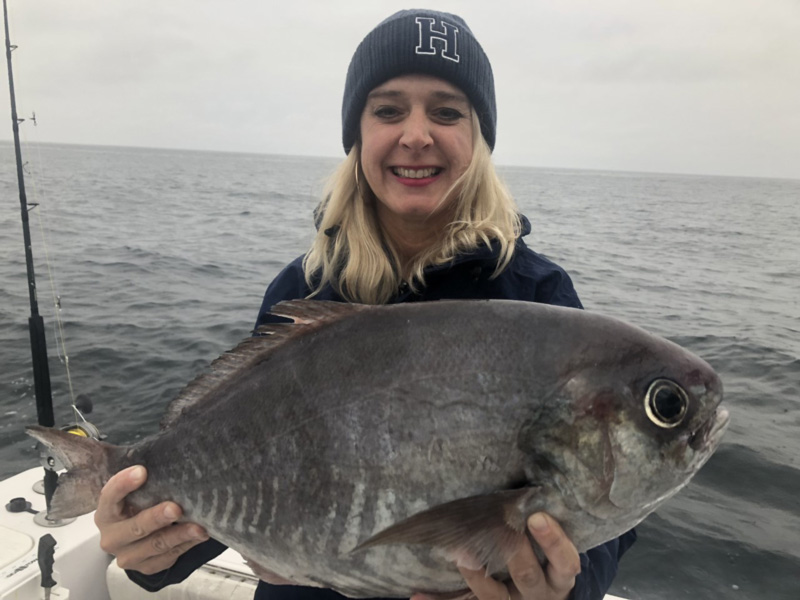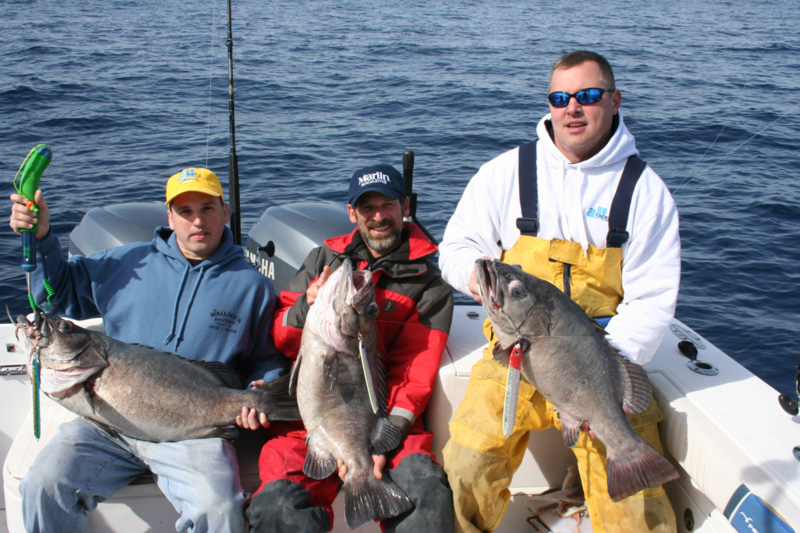With the winter setting in, anglers are faced with certain species migrating away and a slow-down in Chesapeake Bay fishing due to colder temps. A sometimes-necessary cure is to load the boat and take a fishing trip to what I like to call “Candyland.” This entails making a run to the offshore wrecks or the Norfolk canyon for some bottom fishing, before the weather becomes unbearably cold and the boat needs winterized. It’s a great way to stockpile your freezer for the winter, but before making the trip, plan ahead and keep a few things in mind.

Gearing Up for Bottom Fishing
Always have two wreck anchors on the boat. This way if you lose one, you’re not heading back empty-handed because of it. This is especially important if you’re fishing for tautog or sea bass, and wish to anchor on a mound of fish. In this case, precision matters and precise anchoring will give you the best result.
Tip two is that having a durable pair of sharp scissors is as essential as having quality knives in the kitchen, because not only do they help you cut the line faster, they are key to preparing more attractive baits that offer a more enticing presentation to the flounder or golden tilefish. Also invest in a good pair of wire cutters and have them aboard in a clear dry bag or container in case you have to cut a hook that accidentally gets lodged in a thumb or leg while you’re miles from shore. Remember also to always have a freshly stocked first aid kit onboard, in addition to extra winter gear like additional clothing and rain gear.
As far as tackle goes, as with any bottom fishing its important also to have a good size assortment of weights to accommodate wind and current changes. With multiple people fishing aboard the boat, you will need to use enough weight to have your line relatively straight up and down because when sinkers are not heavy enough, the line tends to wander further away from or under the boat — which commonly results in tangles with the person fishing next to you. Bottom line is you didn’t wake up at the crack of dawn to spend the day offshore tangling up and re-rigging.
Voyage to Candyland
The colder the temperature, the deeper the fish usually go — at least that is the case with such species as sea bass. So, what does that mean in terms of location? It means in the late fall/early winter heading to a spot like the Triangle Wrecks will be a good bet, but then by midwinter going further out to areas like the 44 fathoms wreck will probably put you on more consistent action. (Note: at some depths you may encounter hordes of spiny dogfish during the winter. You may need to fish in 800-plus depths, to get completely away from them). Years ago, I frequented the Ocean Venture. I hit that wreck at least once or twice during every season and I found that a wreck that is usually on fire in the late fall and winter was significantly less on fire in the warmer months of the year.
Before leaving, make sure you’re aware of the ever-changing saltwater regulations and any new regulations for your state, and have any necessary permits for fish you wish to target. Blueline and golden tilefish, for example, now require a federal permit with mandatory reporting within 24 hours of the catch.
Rigging and Fishing
When you’re fishing baited hooks in depths of 350 feet or greater, it’s wise to use circle hooks simply because you won’t have to set the hook in deeper water. Use two hooks per rig, so if one bait gets taken, you’ll still have a bait on the other hook and won’t have to crank the line back in to re-bait. For larger species such as golden tiles, no more than two hooks are recommended as they can get very large and heavy and difficult to bring in, especially when hand cranking. You don’t want your risk your rig or line breaking, either, and you’re also less likely to go over the one wreckfish per person regulation that is currently in some states such as Virginia. Finally, for all the paper chasers out there, it’s good to keep in mind that well over 60 world records have been caught in the Norfolk Canyon alone. It’s smart to review your rig, leader lengths, and hook choices with IGFA parameters so that if you do happen to catch a record, you can hopefully receive it.
Extraction Techniques
The bottom fish is a structure dweller, so it already has the edge when you arrive to his neighborhood to engage in the fight. Primary example: the bottom dweller dives into the rocks or wreck after he’s hooked, and fouls your line. Tautog are notorious for this. I have waited as long as 10-plus minutes until the tog thought the coast was clear, and finally started to run again. There are a few methods of madness that are not guaranteed, but can be implemented in that situation to at least try and extract the fish. First, try putting the reel in freespool so that the fish doesn’t feel resistance. This is done in hopes that he will think the coast is clear, and venture back out of the structure. If he does, lock up the reel and lift the rod to catch him off guard, and then start cranking quickly to hopefully get the upper hand. If a tog has gone into his hole or wreck, strumming the line on the fishing rod with a few plucks will sometimes annoy the fish into reacting, and possibly running back out. The third option is to keep a taut line and periodically attempt to pull the fish out. Using this along with strumming the line can sometimes work. Again, there is no guarantee of extraction and even the most quality equipment has its limits.

This brings us to one final tip that is rooted in good old fashioned patience: when your line hits the bottom, not overreacting to the first nibble can sometimes result in catching a nicer fish. Babies eat first, so when your weight first hits the bottom give it a moment — sometimes the patience of not cranking your line up immediately can offer a nice reward. An example of this is a 34.5-pound golden tilefish that resulted from a battle starting more than 900 feet below. I had dropped my line and I felt a hit, but decided not to react immediately and instead waited maybe another minute or so. Then I felt a tug that practically took the rod right out of my hand. I lifted my rod and began cranking as hard as I could, and when I got the golden onto the boat and began to take the hook out of its mouth, I saw a black belly rosefish in there. It was then that I realized what had happened: the rosefish ate the bait strip, but the big golden apparently had his eye on the bait too and with one swift chomp, ate both. However, before the golden even got a chance to gloat about it, I started cranking and took them both out. The point here is that patience sometimes does pay off, and that includes during your last chance late season bottom fishing excursions.
By Beth Synowiec